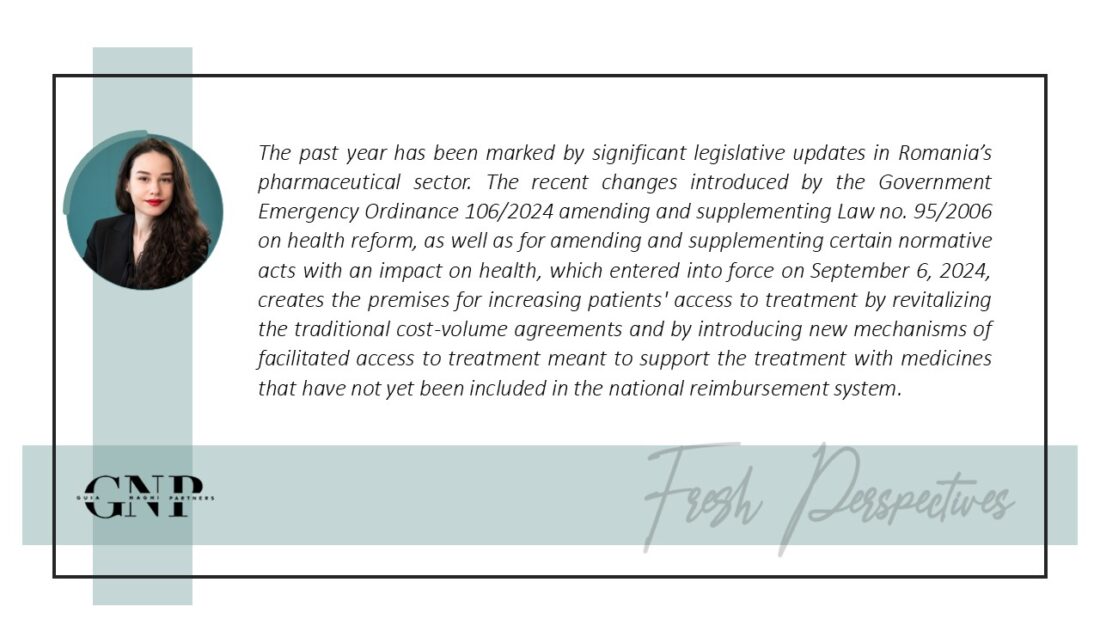Alexandra Stoicescu – Future directions in contractual mechanisms facilitating access to medicines
Ensuring access to innovative medicines for the population is a key objective, recognized at both the European level[1] and at the national level[2], acting as a genuine impetus for national authorities to develop a legal framework that is equally properly aligned with this aim. However, achieving this goal largely relies on the budgetary constraints that influence the proper functioning of the national health insurance system.
Ensuring the financial sustainability of medicine reimbursement was intended to be achieved through the implementation of cost-volume agreements and cost-volume-result agreements concluded between marketing authorization holders (“MAHs”) and the National Health Insurance House (“NHIH”) for medicines that did not receive the score for unconditional inclusion in the List of reimbursed medicines (the “List”) following health technology assessment (“HTA”).
In recent years, budgetary constraints have prevented many medicines from being included in Romania’s reimbursement system. This issue has particularly impacted medicines with conditional inclusion decisions, which were dependent on the conclusion of cost-volume/cost-volume-result agreements. Moreover, unsustainable policies regarding medicine reimbursement have also affected the retention of some of the reimbursed medicines within the system.
On September 6, 2024, the Government Emergency Ordinance 106/2024 amending and supplementing Law no. 95/2006 on health reform, as well as for amending and supplementing certain normative acts with an impact on health (“GEO 106/2024”) entered into force, bringing important legislative amendments also to the Government Emergency Ordinance no. 77/2011 regarding the establishment of contributions for the financing of certain expenses in the field of health (“GEO 77/2011”). In an effort to address both accessibility needs and budgetary efficiency, GEO 106/2024 introduced a new mechanism to facilitate access to treatment and revised important conditions for negotiating cost-volume agreements.
Shifting priorities in the initiation of cost-volume agreements
Cost-volume/cost-volume-result agreements are defined by GEO 77/2011 as mechanisms designed to facilitate access to medicines, meant to ensure financial sustainability and cost predictability within the health system. Under these agreements concluded with NHIH, MAHs—whether Romanian entities or legal representatives of foreign entities —agree to support the treatment of a certain category of patients with medicines included in the List, through quarterly contributions, for a certain amount of time.
Since its introduction, this mechanism established the necessity of adhering to a prioritized order for initiating negotiations, which was based at that time on the following criteria assessed by the Specialized Commission of the Ministry of Health: (i) medicines for diseases in advanced stages without a therapeutic alternative in the List, (ii) medicines approved through the European Medicines Agency’s emergency procedure, and (iii) medicines for specific treatments of diseases with a significant impact on public health, as outlined in Law no. 95/2006 and in the National Health Strategy.
Over time, these criteria have become increasingly insufficient, with their establishment failing to align with the principles of transparency and predictability. Following the adoption of GEO 106/2024, the order of priority has been rethought, as follows:
- Medicines that are already included in the List have priority over those that have not yet been included, for the renegotiation process.
- Among the medicines that are not included in the List, the order of initiation of negotiation is established according to the following criteria:
- medicines with a relevant comparator in the List (as per the HTA Report) which generate less than 3% costs in relation to the comparator;
- orphan medicines and medicines for rare diseases or medicines without a comparator in the List;
- medicines with a relevant comparator in the List and which generate more than 3% costs in relation to the comparator.
This prioritization order applies even for medicines for which the negotiation process has not yet been initiated when GEO 106/2024 entered into force.
The maximum amount within which the cost-volume/cost-volume-result agreements are negotiated and concluded is approved by the annual budget laws and is allocated for medicines that meet these prioritization criteria.
On September 6, 2024, by Emergency Ordinance 107/2024 for the regulation of certain fiscal-budgetary measures in the field of management of budgetary receivables and the budget deficit for the consolidated general budget of Romania in 2024, as well as for amending and supplementing certain normative acts (“GEO 107/2024”), this limit was increased from 4,300,000 thousand lei to 6,200,000 thousand lei, offering renewed hope for medicines awaiting inclusion in the reimbursed system.
Promising introduction of protocols for early access to reimbursement
GEO 106/2024 completes the legal framework of the contractual mechanism for facilitated access to treatment, by introducing the concept of “protocols for early access to reimbursement”, defined as new mechanisms whereby MAHs participate in the co-financing of the treatment for a specific category of patients and for a limited duration (possibly until medicines are included in reimbursement).
These protocols can be concluded both for medicines that received an HTA decision for inclusion in the List and for medicines with an HTA request submitted to the National Agency for Medicines and Medical Devices of Romania (“NAMMDR”), for which no therapeutic alternatives are available.
MAHs participating in these protocols are exempt from paying the claw-back tax or any contributions resulting from cost-volume/cost-volume agreements for the duration of the protocols. Such a legislative solution is justified, given that it is expected that a separate financial contribution will be required for the implementation of this mechanism.
At this point, this new concept is a rather abstract one. The concrete implementation and development of these protocols are expected to be outlined in a subsequent order which has not yet been approved. Therefore, at this stage, the protocols for early access to reimbursement remain inapplicable until further regulatory provisions are established.
Overall, this legislative amendment appears to be encouraging, since this new mechanism could solve the accessibility problems currently faced by medicines waiting to be included in the List, increasing access to treatment for patients even in the case of medicines that have not yet completed the HTA process, if they have no therapeutic alternative. These new early access protocols could thus potentially bridge the gap between patients’ needs for timely, reimbursed treatments and the financial constraints faced by the healthcare system.
All things considered, the manner in which these two significant legislative changes related to facilitated access mechanisms are detailed in future implementation acts will be pivotal in determining the success of efforts to enhance patients’ timely access to innovative treatments.
[1] The Pharmaceutical Strategy for Europe recognizes that one of the basic pillars of the European Union’s health policy is fulfilling unmet medical needs and ensuring accessibility and affordability of medicines.
[2] The General Objective no. 4 of the National Health Strategy for the period 2023-2030 approved by Government Decision no. 1004/2023 is “improving the availability, equitable and timely access to safe and cost-effective health services and medical technologies“.





No Comments